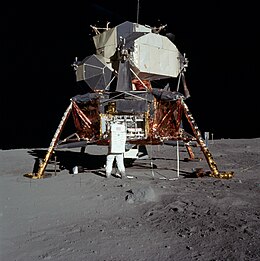Lunar_Module_Eagle
Lunar Module Eagle
Lunar lander used for Apollo 11
Lunar Module Eagle (LM-5) is the spacecraft that served as the crewed lunar lander of Apollo 11, which was the first mission to land humans on the Moon. It was named after the bald eagle, which was featured prominently on the mission insignia. It flew from Earth to lunar orbit on the command module Columbia, and then was flown to the Moon on July 20, 1969, by astronaut Neil Armstrong with navigational assistance from Buzz Aldrin. Eagle's landing created Tranquility Base, named by Armstrong and Aldrin and first announced upon the module's touchdown.
The name of the craft gave rise to the phrase "The Eagle has Landed", the words Armstrong said upon Eagle's touchdown.[2] The phrase was used as the title of a bestselling 1975 book, set during the Second World War, and the 1976 film adaptation.
